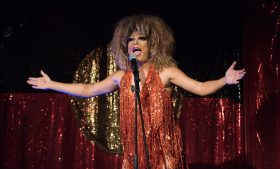Image: Room with vintage TV, on Shutterstock.
How does the prominence of digital technologies now shape the relationship between the performing and the recorded audiovisual medium?
These questions – pondering how the arts is seen and screened on free-to-air TV – are under consideration as the Australian Broadcasting Corporation instigates a drastic change in thinking. Cross-platform, interdisciplinary activities are drawing focus over the current model of repurposing live performances for television, Katrina Sedgwick, Head of Arts ABC TV, told the Australian Performing Arts Market.
For decades, the presentation of the arts on the ABC has focused on broadcasting material created for a live experience. In partnership with the Australia Council for the Arts, the ABC has worked to acquire the rights to performing arts productions, screening them in regular allocated arts programming timeslots.
Alas, although the ABC is unwavering in its commitment to continue its support of the arts on the small screen, audience interest is often variable. Non-prime airtimes may not assist in attracting sizeable viewership; however the stagnant nature of the content model cannot be overlooked. Just as influential: the blurring of boundaries between traditional performance and digital content, shaped into a different breed of work increasingly available online.
On TV, arts programming sits in specific timeslots on the edge of the schedule; that it could rate better is a realistic assessment offered by Sedgwick. A revised framework is required to not just reinvigorate broader viewer interest, but to reshape the content offered. Thinking beyond the bounds of the stage and the screen is crucial in an industry increasingly interlinked with and reliant upon digital capabilities and methods of further dissemination.
In a new way of contemplating the interplay between the performing arts and television, the ABC will endeavour to move past the accepted idea of repurposing performances made for and best seen on stage, expanding the scope of the arts on TV beyond mere transmission and documentation. Thinking big and treading towards the ambitious, trying new things and being more playful, the stated intention is to stop simply filming existing work in favour of projects optimised for small screen viewing – whether through specific targeting towards the medium of TV, multiple versions of works that are adaptable to multiple formats from the outset, or large-scale events produced with television as a fundamental component.
Generating audience engagement across several platforms sits at the heart of the new direction, with the ABC eager to see their target market flit between their avenues – television, radio and online – to interact with arts content. The desire to leverage all channels is a primary driver, as the organisation takes a more holistic approach to the arts, and looks strategically about the content made and distributed across its various arms.
The ABC and the Australia Council for the Arts have been in dialogue since the inception of both organisations; however their formal partnership over the past seven years is now being reshaped to include a broader range of activities on both sides. Where repurposing and filming existing live performance work for television broadcast formed the focus of the existing collaboration, the ABC’s radio and online platforms are now also included.
The collaboration between the organisations will move forward in three areas: artistic practice, programming and sector development. Engaging with practitioners with an eye to cross-platform outcomes, producing significant large-scale works, and cultivating a broader industry focus are at the core of the three branches of activity.
Interconnectivity is key, with the ABC eager to capitalise upon the abilities of the digital environment – including their ABC Arts Online portal. Curating the best arts material from television and radio in one digital space is an act of audience cultivation, of course, including promoting catch-up television viewing. The site attracts visitors generally interested in the arts, introduces them to television arts content they may not have already seen, and affords an opportunity for them to watch outside of the broadcast schedule. ABC Arts Online, in its most basic sense, is being used to build viewers – getting more eyeballs on the content.
‘There are many ways to engage with the ABC,’ Sedgwick noted, explaining that TV success for the arts is difficult to quantify. Trying to find qualitative assessment tools is a work in progress, but something the ABC is keenly seeking with the Australia Council for the Arts and Screen Australia. Looking at the impact of broadcasting the arts beyond pure numbers is their focus, something that again motivates the search to find other models of commissioning and screening content. Of course, there is no easy solution; there is, however, a willingness to rethink the current system to find a better method for the future.





